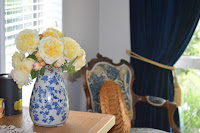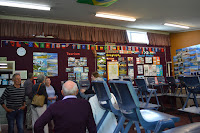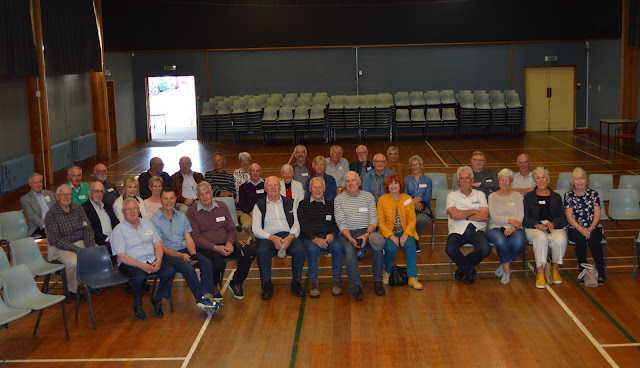 Healthcare issues usually feature in election campaigns; this year was no exception. But even before that, of course, the consequences from Covid-19 were already to the fore. New Zealand has some significant inequalities when it comes to health treatment; cancer being one example, screening for bowel cancer is another. We are so far behind other OECD countries in those areas, so I thought it might be worth taking a look at healthcare pros and cons and performance analyses between NZ and France as things stood before Covid struck. I've been through both systems personally. Firstly, just a few bits of info to give you an idea of the French healthcare system...
Healthcare issues usually feature in election campaigns; this year was no exception. But even before that, of course, the consequences from Covid-19 were already to the fore. New Zealand has some significant inequalities when it comes to health treatment; cancer being one example, screening for bowel cancer is another. We are so far behind other OECD countries in those areas, so I thought it might be worth taking a look at healthcare pros and cons and performance analyses between NZ and France as things stood before Covid struck. I've been through both systems personally. Firstly, just a few bits of info to give you an idea of the French healthcare system...
 Pretty much everyone there has a carte vitale. This green card is presented at the doctor's or pharmacist's to inform the government you are entitled to have public-funded care and it is handled automatically. If you are employed in France 70% of your medical costs are covered so you just pay the balance at the consultation. For seniors in France who are 65 or older, or individuals with chronic illnesses such as cancer, the services are fully covered.
Pretty much everyone there has a carte vitale. This green card is presented at the doctor's or pharmacist's to inform the government you are entitled to have public-funded care and it is handled automatically. If you are employed in France 70% of your medical costs are covered so you just pay the balance at the consultation. For seniors in France who are 65 or older, or individuals with chronic illnesses such as cancer, the services are fully covered.
To pay for additional services like chiropractors or long-term care at
private hospitals, or to cover the remaining 30% of the basic care,
individuals can purchase private insurance. I wish I had known that when I first arrived in France. I discovered I had to pay hundreds of euros before I could check out of a hospital there as only 70% was covered by the public system. A hard lesson and one I instantly rectified by taking out additional insurance. It's a system which means most costs for almost everyone are covered, though dentistry can still be a challenge.That means that healthcare in France is some of the most
subsidised and affordable in the world but it is a big drain on the government budget.
Now, let's take a look at the statistics pre-covid 19. The main source for these statistics is Le Point 21 November 2019 which published the Panorama report from the OECD.
The OECD ranks democratic countries with market-led economies. Le Point
ranked them according to FIVE themes: access to care, state of health,
risk factors, quality of care, resources. Overall France was ranked 9th,
with New Zealand 13th. Australia was 6th.
Two things that plunge France and NZ into the area of risk factors for the health system are tobacco and alcohol. Two other risk areas are the high prescription rates and a lack of doctors, especially in rural areas. Mental health is the fifth risk area. It can take three months or more to get a first appointment with a psychiatrist in France. It's no better in NZ.
There are too many suicides in France, the rate is the highest in the OECD but NZ is up there too, as we know, particularly in certain gender and age categories. Overall, France has 13.1/1000 inhabitants, while NZ has 11.5.
 When it comes to general health ranking France does better; 82.6 is the average life expectancy, 154 for mortality rate of avoidable deaths/100,000 inhabitants, 4.8% of the adult population have diabetes. New Zealand has an average life expectancy of 81.9 years, 178 avoidable deaths per 100,000 inhabitants, 8.1% of the population have diabetes (sadly no surprise there, possibly due to us being the 3rd most obese country in the world).
When it comes to general health ranking France does better; 82.6 is the average life expectancy, 154 for mortality rate of avoidable deaths/100,000 inhabitants, 4.8% of the adult population have diabetes. New Zealand has an average life expectancy of 81.9 years, 178 avoidable deaths per 100,000 inhabitants, 8.1% of the population have diabetes (sadly no surprise there, possibly due to us being the 3rd most obese country in the world).
In France and also, I am finding, in NZ the new generation of doctors, largely the female ones, have no interest in working as their predecessors did (60 hours per week) which makes it very difficult to obtain appointments in either country, especially if your doctor is a female with children, working a few hours a week. Both countries have an under-supply of GPs and other doctors.
Ease of access to care: New Zealand 5th ( 100% population coverage for primary care, 78.6% spent on public sector), France 6th (99.9% population covereage, 77.1% spent on public sector).
As a contrast, the United States sends the most on health for very average results.
Risk factors that are not well controlled
Tobacco: France 25.4% smoke daily, NZ 13.8% no surprises there; Alcohol: France 11.7 litres drunk per adult per year, NZ 8.8litres; Obesity: France 49% of population, NZ 66.6%.
French doctors are often hostile to any suggestion some of their tasks could be delegated to pharmacists or nurses, such as vaccinations. This is not a constructive attitude, very protectionist, whereas in NZ pharmacists can give flu jabs, as can nurses, smear tests are done by nurses etc so that doctors can concentrate their time on more complicated consultations.
 Quality of care (looking at the use of antibiotics, asthma, death after a heart attack, survival after breast cancer)
Quality of care (looking at the use of antibiotics, asthma, death after a heart attack, survival after breast cancer)
France prescribes 23 daily doses of antibiotics per 1000 inhabitants, NZ 25.8 daily doses. France admits 150 patients for asthma or chronic pulmonary obstruction per 100,000 inhabitants, NZ a whopping 363. France has a rate of 5.6 deaths from heart attack per 100,000 inhabitants during the 30 days following the infarctus, NZ 4.7. France has a rate of 87 surviving breast cancer for 5 years, NZ has 87.6.
Fulltime nurses in hospitals in France receive the equivalent of 38.5 euros compared to NZ nurses 49 euros. French nurses have a guaranteed employent and good pensions but are very poorly paid. The average across the OECD is 44.5 (currency, purchase power and parity have been adjusted in these figures).
French people judge inequality of access to healthcare as inacceptable, far ahead of the inequalities of housing, income etc, men and women. They insist on equal access for all, even if you have no money. In NZ we seem to accept that if you don't have medical insurance or are a beneficiary etc then you can expect to possibly die as a result of lack of access to good health care, including medications.
Healthcare spending per inhabitant
France spends $4964.7 compared to NZ $3922.6. There are 3.2 doctors per 1000 inhabitants in France, NZ has 3.3. The OECD average is 3.5.
The number of hospital beds per 100 inhabitants
France has a whopping 6 beds. NZ has 2.7 beds. It seems other countries can supply good quality care for less beds than the French system. Wastage of resources represents 20% of expenses on healthcare in OECD countries. This includes hospitalisations for diabetes and cardiac insufficiency which could be treated via primary care providers, prescriptions that are not necessary, insufficient use of generic drugs. The average stay in a healthcare establishment (medical, surgical or obstetric) is 9.9 days in France, yet only 7.1 in NZ. Are we rushing kiwi patients out the door or is France being too generous?
It's anyone's guess what deleterious effects the pandemic will have on quality and type of care in OECD countries from now on but keeping the pandemic 'under control' MUST be a positive thing in terms of preserving our health systems and access.
 This week I thought back two years to the day I moved into my new home/newbuild. It was exciting and scary to build a
home while unemployed but I enjoyed making the thousand-and-one
decisions on my home and garden. Each has been completely personalised.
This week I thought back two years to the day I moved into my new home/newbuild. It was exciting and scary to build a
home while unemployed but I enjoyed making the thousand-and-one
decisions on my home and garden. Each has been completely personalised. 

 It's good to step back and look at progress to see that the sacrifices and effort do indeed bear 'fruit'. I can now look out of each window and see a pretty vista specifically designed to add value to my interior decor.
It's good to step back and look at progress to see that the sacrifices and effort do indeed bear 'fruit'. I can now look out of each window and see a pretty vista specifically designed to add value to my interior decor.  Climbing roses and grape vines add such a 3-D effect. Delphiniums and other herbaceous perennials add a romantic air and on a warm summer evening I can choose to sit outside on my patios, garden lighting switched on, and dream of the progress I might see in another two years. The hard stuff may be finished but the gardening effort never will be. Over winter I can hunker down and enjoy my home, working on other projects I am planning. I'll keep you posted.
Climbing roses and grape vines add such a 3-D effect. Delphiniums and other herbaceous perennials add a romantic air and on a warm summer evening I can choose to sit outside on my patios, garden lighting switched on, and dream of the progress I might see in another two years. The hard stuff may be finished but the gardening effort never will be. Over winter I can hunker down and enjoy my home, working on other projects I am planning. I'll keep you posted.
























































